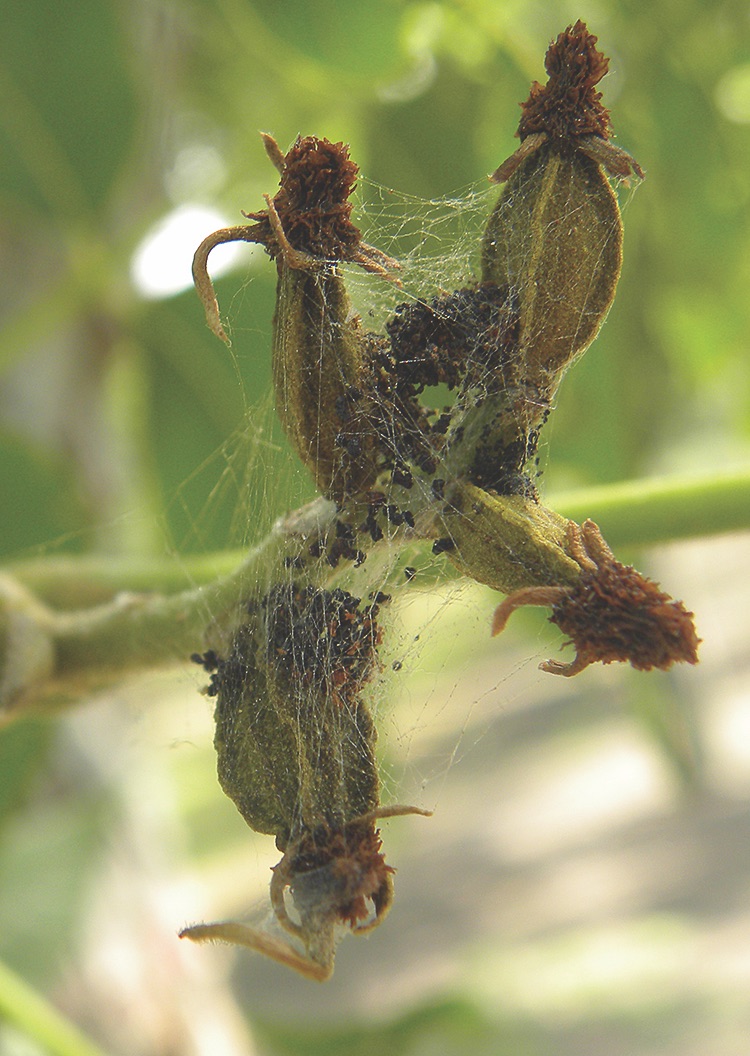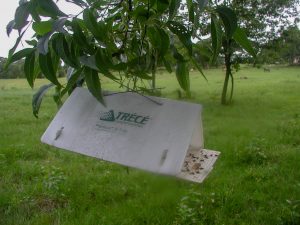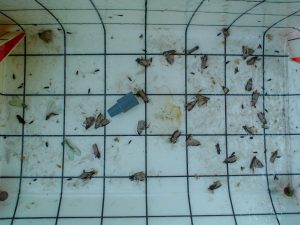Spring Has Arrived, Time to Order PNC Pheromone Traps

These nutlets are suffering from extensive pecan nut casebearer damage. (Photo by Bill Ree)
I feel that anyone in the pecan business knows the importance of monitoring for and managing the pecan nut casebearer. Fortunately, as an industry, we have an excellent tool to combat this insect in the form of a pheromone trap and prediction model.

Here’s one example of a PNC pheromone trap that has already made a number of catches. (Photo by Bill Ree)
As with many insects, pecan nut casebearer (PNC) develop according to temperature and not a calendar schedule, so knowing when to be in the orchard at the right time to make a management decision will vary from year to year. During 2017 we had a very warm winter and, in some Texas counties, the first-generation flight of PNC adults was two weeks earlier than normal. In this case, pheromone traps paid for themselves by alerting producers to the early activity.
Another example of the variation of PNC activity is data that was sent to me from a producer in Fort Bend County who provided me with 10 years of first trap catch information. During 2012, with an exceptionally warm spring, this producer’s first catch via trap was on Apr. 9, which was 19 days earlier than any previous catch for the previous 10 years. Across the 10 years, the dates for first trap catch ranged from Apr. 9 to Apr. 28.
Detecting this onset of the first-generation PNC flight is important because it establishes a benchmark to determine the start of egg lay and dates of the start of nut entry. As a general rule, egg lay starts 7 to 10 days after the first catch with nut entry starting 12 to 16 days after first catch. For trap usage, we feel that three traps are sufficient for a 50-acre orchard or less and at least five traps should be used for orchards larger than 50 acres. These PNC pheromone traps can be ordered as kits from many businesses that cater to the pecan industry. There are several different variations of traps and they all work. Most kits will come with extra lures, and any lure that is not used for the first generation should be stored in the freezer. Pheromone traps stored in the freezer will stay viable for years.

Adult pecan nut casebearers were caught in this pheromone trap, signaling that a management plan may be required to protect the coming crop. (Photo by Bill Ree)
The key to obtaining good trap data is to have the traps in the orchard about two to three weeks prior to an average spray date to ensure that the start of the flight is detected. Ideally, traps should be checked daily but not everyone can do that, so three observations a week will work. Initial trap observations should have no catches or zero data. This zero trap catch data is important for it defines first catch. The first catch is defined as the first catch date when there are collections for two consecutive observations.
For several years, the Texas Pecan IPM program has been providing producers with online activity maps and site-specific predictions for egg lay online under the Maps link. When you access the Map link, you will see it has two basic components—a PNC risk map and a PNC forecast map. At this time, it is not known if the PNC Risk Map which comes from volunteer producers, who provide their trap data, will be up and running. However, the PNC Forecast model should be working.
If a producer is running their own traps, a prediction for oviposition or egg lay can be made for that individual orchard using the PNC Forecast prediction model. All that is needed for the producer to make their own prediction for egg lay is to mark their orchard location on the map then enter a first trap catch date in the box on the upper right corner. The program will then calculate probable dates of various stages of egg lay. The program will provide dates for 10, 25, 50, 75 and 90 percent completion of egg lay. The ideal time for scouting and making treatment decisions will be between the dates for 25 and 50 completions of egg lay, which is about a three-day time period.
Although the trapping data and prediction maps can provide a producer with a wealth of information, it still takes a producer being in the orchard to observe activity, evaluate crop loads and use their understanding of orchard conditions and operations to make that final management decision of treat or don’t treat. So this spring, while examining your PNC data, don’t forget to take your time playing detective before finalizing your management plans.

